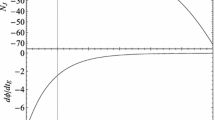Abstract
We propose a new potential for inflation with a single-field component. We evaluate the evolution of the slow-roll parameters in our model and find that they are small at the beginning of inflation. We thus apply the slow-roll approximation to calculate the scalar spectral tilt \(n_s\) and the tensor-to-scalar ratio r. We also calculate the non-Gaussianity \(f_{NL}\) in the model using the package BINGO. The analysis of the model is compared with the latest Planck data on \(n_s\), r and \(f_{NL}\). A good agreement with those data is found.




Similar content being viewed by others
References
A.A. Starobinsky, Phys. Lett. B 91, 99 (1980)
A.H. Guth, Phys. Rev. D 23, 347 (1981)
A. Albrecht, P.J. Steinhardt, Phys. Rev. Lett. 48, 1220 (1982)
A.D. Linde, Phys. Lett. B 108, 389 (1982)
A.D. Linde, Particle Physics and Infationary Cosmology (Harwood, Chur, 1990)
A.R. Liddle, D.H. Lyth, Cosmological Infation and Large-Scale Structure (Cambridge University Press, Cambridge, 2000)
D.H. Lyth, A.R. Liddle, THE Priordial Density Perturbation (Cambridge University Press, Cambridge, 2009)
A. Mazumdar, J. Rocher, Phys. Rept. 497, 85 (2011). arXiv:1001.0993 [hep-ph]
P. A. R. Ade et al. [Planck Collaboration], arXiv:1303.5082 [astro-ph.CO]
P.A.R. Ade et al., [Planck Collaboration], Astron. Astrophys. 594, A20 (2016). arXiv:1502.02114 [astro-ph.CO]
Y. Akrami et al. [Planck Collaboration], arXiv:1807.06211 [astro-ph.CO]
C.L. Bennett et al. [WMAP Collaboration], Astrophys. J. Suppl. 208, 20 (2013). arXiv:1212.5225 [astro-ph.CO]
G. Hinshaw et al. [WMAP Collaboration], Astrophys. J. Suppl. 208, 19 (2013) https://doi.org/10.1088/0067-0049/208/2/19, arXiv:1212.5226 [astro-ph.CO]
E. Wong, B.C. Robertson, K.V.K. Iyengar, D.M. Sheppard, W.C. Olsen, Nucl. Phys. A 192, 279 (1972)
A.A. Starobinsky, Sov. Astron. Lett. 9, 302 (1983)
L. Wang, E. Pukartas, A. Mazumdar, JCAP 1307, 019 (2013). arXiv:1303.5351 [hep-ph]
S. Choudhury, A. Mazumdar, Nucl. Phys. B 882, 386 (2014). arXiv:1306.4496 [hep-ph]
V. Vennin, K. Koyama, D. Wands, JCAP 1511, 008 (2015). arXiv:1507.07575 [astro-ph.CO]
R. Kallosh, A. Linde, D. Roest, Phys. Rev. Lett. 112(1), 011303 (2014). arXiv:1310.3950 [hep-th]
T. Tenkanen, JCAP 1712(12), 001 (2017). arXiv:1710.02758 [astro-ph.CO]
Z. Lu, JCAP 1311, 038 (2013). arXiv:1311.0348 [hep-th]
R. Kallosh, A. Linde, JCAP 1306, 028 (2013). arXiv:1306.3214 [hep-th]
A.D. Linde, Chaotic Inflation. Phys. Lett. B 129, 177 (1983)
R. Kallosh, A. Linde, JCAP 1306, 027 (2013). arXiv:1306.3211 [hep-th]
A. Ashoorioon, K. Dimopoulos, M.M. Sheikh-Jabbari, G. Shiu. arXiv:1306.4914 [hep-th]
D.K. Hazra, L. Sriramkumar, J. Martin, JCAP 1305, 026 (2013). arXiv:1201.0926 [astro-ph.CO]
V. Sreenath, D.K. Hazra, L. Sriramkumar, JCAP 1502(02), 029 (2015). arXiv:1410.0252 [astro-ph.CO]
V.F. Mukhanov, Sov. Phys. JETP 67, 1297 (1988)
M. Sasaki, Prog. Theor. Phys. 76, 1036 (1986)
A.R. Liddle, D.H. Lyth, Phys. Lett. B 291, 391 (1992)
A.R. Liddle, D.H. Lyth, Phys. Rept. 231, 1 (1993)
D.K. Hazra, A. Shafieloo, G.F. Smoot, A.A. Starobinsky, JCAP 1408, 048 (2014). arXiv:1405.2012 [astro-ph.CO]
J.M. Maldacena, JHEP 0305, 013 (2003). arXiv:astro-ph/0210603
P. A. R. Ade et al. [Planck Collaboration], Astron. Astrophys. 571, A24 (2014) https://doi.org/10.1051/0004-6361/201321554, arXiv:1303.5084 [astro-ph.CO]
Y. Akrami et al. [Planck Collaboration], arXiv:1905.05697 [astro-ph.CO]
D.K. Hazra, A. Shafieloo, G.F. Smoot, A.A. Starobinsky, Phys. Rev. Lett. 113(7), 071301 (2014)
V. Acquaviva, N. Bartolo, S. Matarrese, A. Riotto, Nucl. Phys. B 667, 119 (2003). arXiv:astro-ph/0209156
D. Baumann. arXiv:0907.5424 [hep-th]
R.W. Brankin, I. Gladwell, L.F. Shampine, RKSUITE: A suite of Runge–Kutta codes for the initial value problem for ODEs, Softreport 92–S1 (Department of Mathematics, Southern Methodist University, Dallas Texas, 1992)
Acknowledgements
This work is partially supported by the National Natural Science Foundation of China (NSFC) with Grant No. 11575043.
Author information
Authors and Affiliations
Corresponding author
Appendix
Appendix
Here, we provide the algorithm of BINGO which is used to calculate the power spectra and the non-Gaussianity. We also present our specified code used in the calculation within our model potential.
As described in detail in Ref. [26], BINGO solves the background as well as the perturbation equations using RKSUITE [39], which is a publicly available routine employing Runge–Kutta method to solve ordinary differential equations with initial value condition. The number of e-folds is treated as the independent variable, which allows for an efficient and accurate computation. To obtain the power spectrum \(P_s\), the standard Bunch–Davies initial conditions on the perturbations are imposed when the modes are well inside the Hubble radius, and the modes are evolved until suitably late times. Having obtained the behavior of the background and the modes, BINGO carries out the integrals involved in arriving at the bispectrum using the method of adaptive quadrature. In the equilateral limit of the bispectrum which is our case, each of the modes of interest can be evolved independently and the integrals for the modes can be calculated separately. The integrals contain a cutoff in the sub-Hubble limit, which is essential for singling out the perturbative vacuum.
The computation code of our model which we implement into BINGO is as follows.

Rights and permissions
About this article
Cite this article
Lu, Z., Yuan, J. A study on inflation with a single-field potential in slow-roll approximation. Eur. Phys. J. Plus 135, 293 (2020). https://doi.org/10.1140/epjp/s13360-020-00301-2
Received:
Accepted:
Published:
DOI: https://doi.org/10.1140/epjp/s13360-020-00301-2



